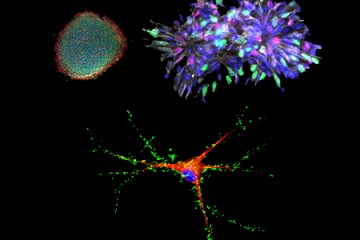Johns Hopkins researchers have succeeded in genetically engineering mice to display traits of bipolar disorder—which turned out to respond well to human treatments like lithium.
By manipulating a specific brain protein, the researchers triggered overexcited behavior in the mice in line with the "mania" of bipolar disorder. Exposing those altered mice to stressors also brought out the depressive side of the mental disorder, which is marked by swings between the two moods.
Video credit: Johns Hopkins Medicine
Researchers say their findings, published this month in the journal PNAS, may improve understanding of how genes linked to bipolar risk change neural circuits in the brain. The mental illness is estimated to affect 2.6 percent of adults in the U.S., according to the National Institute of Mental Health.
"Mouse behavior isn't the same as human behavior, so we need to be cautious, but we were surprised and heartened by the fact that the mutant mice responded to lithium treatment—a gold standard for treating human bipolar disorder and alleviating features of mania and depression," says Christopher Ross, professor of psychiatry and behavioral sciences at the Johns Hopkins University School of Medicine. "To our knowledge, this is the first robust mouse model of bipolar disorder based on a genome-wide significant risk factor for the human disorder."
The researchers specifically altered a protein called "ankyrin-G"—believed to be linked to bipolar disorder in humans. With the mice they reduced levels of ankyrin-G in the front of the brain, the region thought to be most relevant for psychiatric disorders.
When tested in an empty chamber, the mice with mutated ankyrin-G were more active and spent much more time in open space than normal mice, which tend to hug the walls. The normal mice ventured into open space an average of 9,000 times per hour at their most active, vs. 20,000 times per hour for the mutated mice—which were also active for longer periods.
Ross says that because the hyperactivity could be interpreted as a "mania-like" symptom, the researchers fed the mice either lithium or valporic acid (an anti-seizure drug also used to treat mania) over two weeks. Remarkably, with the drug treatments the activity levels in those mice returned to normal.
To test the depressive aspect of bipolar disorder, the team created a stressor for the genetically altered mice, pairing them for periods with a bigger "bully" mouse. (In humans, while mania seems to occur spontaneously, depression tends to occur after some sort of trigger or stressor.)
In subsequent swim tests, the mice exposed to the stressor were quick to give up and remain floating still in the water.
"One way to interpret these results is that the mutant mice were quick to give in to defeat after feeling bullied, and switched to a depressive-like state, which was the opposite of their hyperactive, less-anxious norm," says Shanshan Zhu, the study's lead author and researcher in Ross' lab.
The research group hopes to use its ankyrin-G mice to to help clarify how lithium works to treat bipolar disorder and to test new treatments.
Read more from Hopkins MedicinePosted in Health
Tagged genetics, neuroscience, mental health, bipolar disorder









